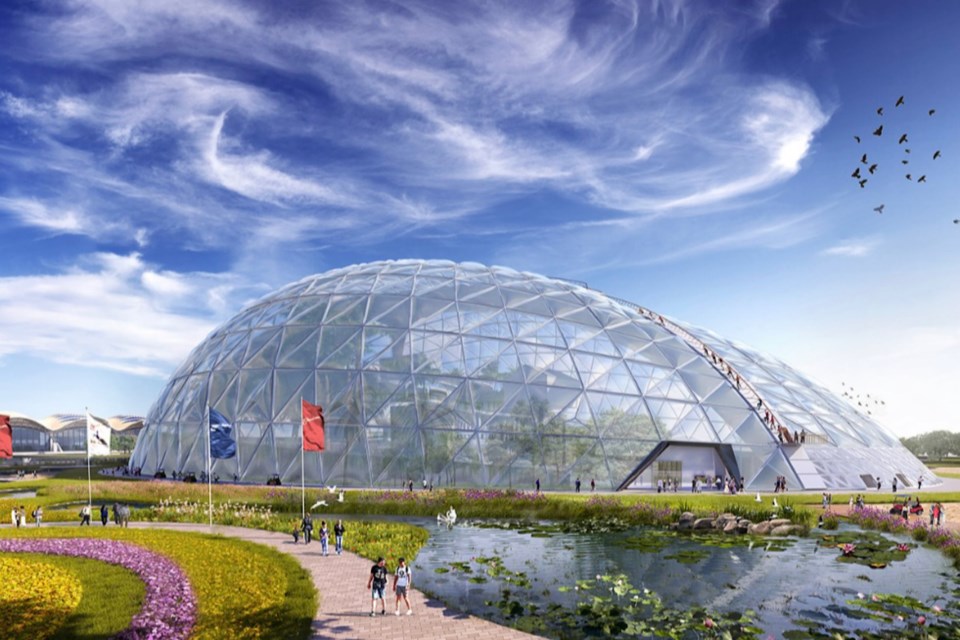Can a post-industrial brownfield site on the Sault waterfront be transformed into a new eco-district?
The people assembling a plan for Sault Ste. Marie's waterfront think it's possible.
They're envisioning a collection of greenhouse biodomes on the old Suncor property on Bay Street next to Purvis Marine and the Canadian Bushplane Heritage Centre.
The domes will "replicate different climates (tropical, mediterranean and temperate) showcasing habitats of plant species from around the world," they said in a draft presentation made earlier this month to municipal politicians from the Ontario and Michigan Saults.
"After sitting vacant and underutilized ... this prime waterfront brownfield property will be transformed into a vast natural parkland to enhance the physical, mental and emotional well-being for all who will experience it," the presentation promised.
"The park will focus on ecological landscape features that promote sustainability while enhancing wildlife and human values."
The 9.3-acre property was used to store petroleum for half a century.
It's stood vacant for four decades.
Its soil is known to be contaminated with lead and petroleum hydrocarbons, to such a degree that when city officials were talking to the Calgary-based energy giant about buying the land in 2017, Suncor insisted any deal be conditional on a gag order preventing disclosure of its latest environment findings.
If city council agrees to implement the new eco-district as recommended by city planners and consultant Nick Onody from O2 Planning and Design, the property will become a place for reconnection and for developing the understandings needed to tackle climate resiliency.
This is not the first time there's been big talk of biodomes and eco-education on the Sault waterfront.
In 2005, developer Philip Garforth was talking about a $25-million dome on the Gateway site, enclosing a boreal rainforest ecosystem year-round.
Garforth promised us the dome, as well as a 200-room Radisson hotel, an ice hotel nearby, entertainment centre, Mayan pyramids, waterfalls, rides and even a haunted forest with animatronic animals as part of his $55-million Borealis development.
He'd bring ZZ Top and Michael Bolton to the Sault.
The opening act would be Diana Ross.
He'd triple the city's population.
In the end, pretty much the only thing Philip Garforth ever erected on the Gateway property was a construction trailer borrowed from S&T Electrical Contractors Ltd.
In 2018, the Green Party's Kara Flannigan floated the idea of a giant dome-enclosed indoor beach on the Sault's waterfront.
It never happened.
Aside from a biodome, other design elements proposed in the new waterfront plan include:
- trails and boardwalks surrounded with native plants, encouraging plant awareness and education
- connection to the water’s edge with created wetlands that showcase environments and habitat
- a wide variety of birds, mammals, insects, and fish will be observed in nature once established
- similar species of insects, amphibians, reptiles and birds can also be viewed in the Bushplane Museum after enjoying the outdoor park experience
- constructed landscapes provide educational opportunities
"With a focus on restoring nature, this large-scale transformation of the Suncor lands will create a waterfront park that provides a cultural and educational space in which sustainability will take root along the water’s edge, within the city and for future generations," the draft plan says.
How long will it take to achieve the new vision for our waterfront, and who's going to foot the bill?
A final draft of the waterfront plan, complete with rough cost estimates and a timeline for phasing and implementation, is to be ready by the end of this month.
"It will have costing associated," says consultant Onody.
"But understand that because there's a lot of private sites here, there's a lot of moving parts here.
"We see this as a long-term vision like most waterfront plans that we do. We talk about a 35- to 40-year vision.
"There's lots of things that happen right. It's not to say that a lot won't get done in a certain timeframe. But what we will ensure is that there are very critical projects that happen early on that we call quick wins.
"That will really set the tone and allow development to continue through revenue enhancements through opportunities to get different grants and other things, because we're doing things properly and the right way that are parlaying into different projects down the road."
The final choice on whether to adopt any of the recommendations lies with city council.
